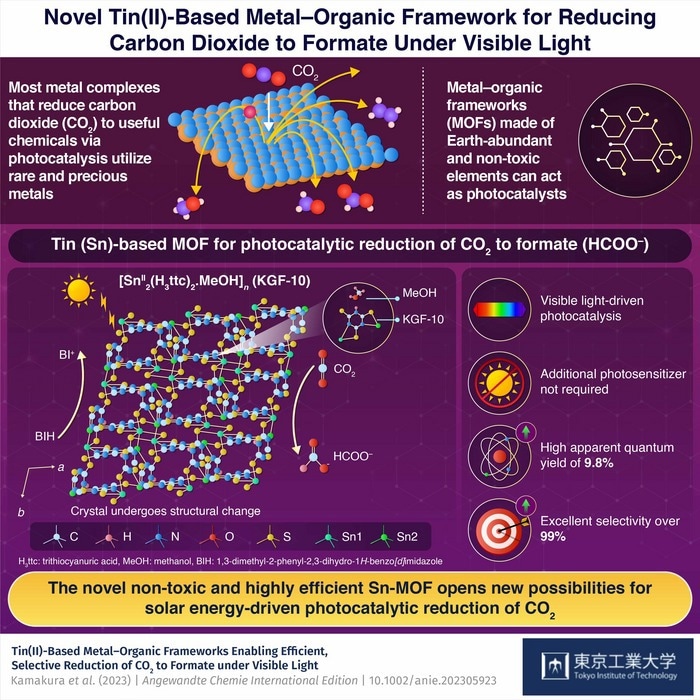The constant need for carbon-rich fuels to power the economy increases atmospheric carbon dioxide (CO2). Even if efforts are being made to cut CO2 emissions, this will not be enough to reverse the harmful impacts of the gas that is already in the atmosphere.

Image Credit: Tokyo Tech
So, by converting atmospheric CO2 into useful molecules like formic acid (HCOOH) and methanol, scientists have developed creative methods to exploit the CO2 that is already present in the atmosphere. The photocatalytic photoreduction of CO2 using visible light is a common technique for carrying out such conversions.
A group of scientists from the Tokyo Institute of Technology, under the direction of Prof. Kazuhiko Maeda, has made a significant advancement that was documented in Angewandte Chemie, International Edition, on May 8th, 2023.
They created a metal-organic framework (MOF) based on tin that permits selective CO2 photoreduction. A brand-new tin (Sn)-based MOF with the chemical formula [SnII2(H3ttc)2.MeOH]n (H3ttc: trithiocyanuric acid and MeOH: methanol) has been outlined by the researchers.
It successfully converted CO2 into HCOOH when there was visible light present.
Most high-performance CO2 reduction photocatalysts driven by visible light rely on rare, precious metals as principal components. Furthermore, integrating the functions of light absorption and catalysis into a single molecular unit made up of abundant metals has remained a long-standing challenge. Hence, Sn was the ideal candidate as it can overcome both challenges.
Kazuhiko Maeda, Professor, Tokyo Institute of Technology
The best of both metals and organic materials could be found in MOFs, which are being investigated as a more environmentally friendly substitute for traditional rare-earth metal-based photocatalysts.
Sn is a potential option for MOF-based photocatalysts due to its well-known capacity to serve as both a catalyst and an absorber during a photocatalytic process. While lead, iron, and zirconium-based MOFs have been extensively studied, not much is known about Sn-based MOFs.
H3ttc, MeOH, and tin chloride were utilized as the starting ingredients for manufacturing the Sn-based MOF KGF-10, and the researchers decided to employ 1,3-dimethyl-2-phenyl-2,3-dihydro-1H-benzo[d]imidazole as the electron donor and hydrogen source.
The produced KGF-10 was then put through a variety of analytical processes. They found that the substance had a bandgap of 2.5 eV, absorbed visible light wavelengths, and had a moderate capacity for CO2 adsorption.
Once scientists were aware of the novel material’s physical and chemical characteristics, they employed it to catalyze the reduction of CO2 in the presence of visible light. They discovered that KGF-10 converted CO2 into formate (HCOO–) effectively and selectively with 99% efficiency without the requirement for an additional photosensitizer or catalyst.
It also had a record-high apparent quantum yield of 9.8% at 400 nm (the ratio of the number of electrons engaged in the reaction to the total number of incident photons). In addition, structural analyses performed throughout the reactions indicated that KGF-10 experienced structural modifications, aiding photocatalytic reduction.
In this study, a high-performance, single-component photocatalyst based on tin that is devoid of precious metals and drives the conversion of CO2 to formate was introduced for the first time. The team’s remarkable KGF-10 characteristics have opened up new possibilities for its use as a photocatalyst in processes like solar energy-driven CO2 reduction.
Prof. Maeda concluded, “The results of our study are a testimony to the fact that MOFs can be a platform for creating outstanding photocatalytic functions, usually unattainable with molecular metal complexes, using non-toxic, inexpensive, and Earth-abundant metals.”
Journal Reference
Kamakura, Y., et al. (2023) Tin (II)-Based Metal–Organic Frameworks Enabling Efficient, Selective Reduction of CO2 to Formate under Visible Light. Angewandte Chemie, International Edition. doi:10.1002/anie.202305923